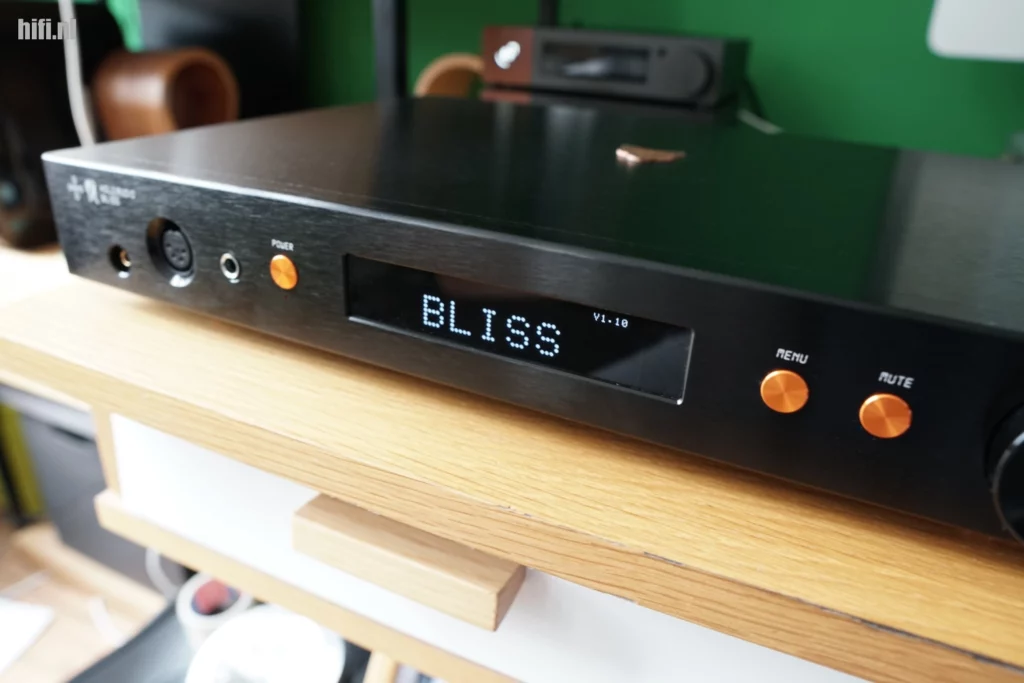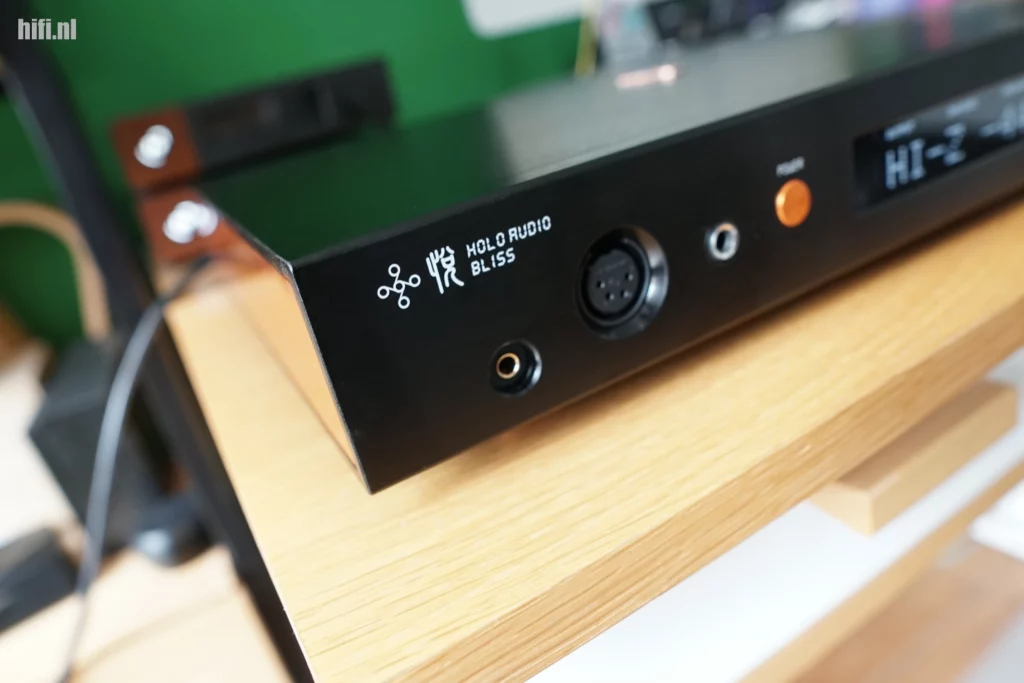REVIEWHOLOAUDIO
REVIEW HOLOAUDIO BLISS KITSUNE: COMMITMENT FIRST
JAMIE BIESEMANS | 01 JUYI 2023 | FOTOGRAFIE JAMIE BIESEMANS | HOLOAUDIO
RESUME
Big? Yes, that is the Bliss. In exchange you get a headphone amplifier with abysmal power that should be able to drive almost anything. However, it’s not just about pure power. The Bliss adds a touch of color to make it cozy and ear-friendly, but doesn’t overdo it. Nothing is lost.
PROS
- Very powerful
- Universally applicable
- Lots of involvement and good separation
- Top shelf build quality
- Adjustable output impedance
CONS
- Less suitable for desktop use
- Not ultimate neutrality, but full of life
- Remote optional at Level 1

We mainly know HoloAudio from their handsome and quirky DACs. However, you will find a lot of other fine equipment at the young brand. Like this new Bliss, a powerful Class A headphone amplifier with a luxurious design that completely matches the Holo DACs.
Holo Audio
A few years ago we got to know HoloAudio during a review of the Spring 3 Level 2, a separate DAC with a very special structure. The Chinese brand of engineer Jeff Zhu has become known for R2R DACs. So not by implementing well-known delta-sigma DAC chips, but by converting from digital to analog via a network of resistors (actually an FPGA). All very interesting, but in this review we look at a different device: the Bliss.
HoloAudio has been doing more than building DACs for some time now; we often hear praise for their Red network transport. The Bliss amp is brand new and aims straight at the heart of headphone enthusiasts. The brand does this with balanced class A amplification that can deliver up to 12 watts at 32 ohms. No, that’s not a typo. Power enough, we think. Also for very tough headphones. Holo therefore dares to position the Bliss as an ultimate solution. That is daring, because despite the starting price tag of 3,400 euros, there are still many more expensive challengers in headfi land that position themselves even more as the ultimate headphone amplifier.

One more thing: in this review we will consistently call the Bliss a headphone amplifier. However, you could also use it as a preamplifier with – say – a pair of active speakers or an output stage. Since Holo positions it primarily for headphone use, we’re going to focus on that scenario.
Two levels
One of the quirky sides of HoloAudio is that they like to offer multiple versions of their products. For example, you have the DACs in two ‘Levels’ and then an ultimate Kitsune version that was tuned in the US. That is also the case with the Bliss. There is an L1 ver
 sion that costs 3,390 euros, while the Kitsune edition costs 500 euros more. For that additional cost, many tweaks have been carried out with that KTE that, according to the manufacturer, have a significant impact on the reproduction. sion that costs 3,390 euros, while the Kitsune edition costs 500 euros more. For that additional cost, many tweaks have been carried out with that KTE that, according to the manufacturer, have a significant impact on the reproduction.
For example, all internal copper wire has been replaced with pure silver wire, the capacitors have been upgraded to AudioNote Kasei ones, the connectors have been replaced with better ones, and the linear power supply has been addressed. Looking inside the Bliss, this power supply looks like a toroidal transformer, but it is a custom-made Dual O type. The KTE edition also comes with a remote control, with the Level 1 this is optional. Kitsune is Japanese for ‘fox’, which immediately explains the logo on the top of the more expensive model. If we consider all that, it seems logical to immediately go for the KTE version. If you still go for an ultimate solution, then the is more than reasonable.

Beautiful copper color
The Bliss is not a cheap headphone amplifier. Fortunately, the device really radiates that it is expensive. It fits perfectly and looks very slick. In that respect, the Chinese brand is without a doubt at the top of the world. Personally, we like that contrast between the black brushed aluminum of the housing and the copper colored panels on the sides. What makes it even tighter is that the side panels are recessed into the whole. You can also see the fiery copper color on the front buttons. And with the remote, a rare example of a remote control that appears to be exactly as expensive as the device itself. You see that less often than you might think; we think of, for example, Devialet or Musical Fidelity with its Nu-Vista line that (just like Holo here) does not drop the ball in this area.
By using the same design language as the Spring and May DACs, the story is completely correct when you combine the Bliss with one of those remarkable R2R DACs from Holo. Also with the May, which comes with a separate power supply that also fits in the same housing. You then get a really nice stack that can count as an ‘end-game’ headfi solution, we think.
More unusual for a headphone amplifier, the Bliss is the size of a typical hi-fi component. However, it is less high, which makes it look very slimline. If you lift him up, you’re going to sigh. It weighs a lot more than you’d expect, thanks to the large power supply and solid housing. You have to take those dimensions into account if you’re looking for a headphone amplifier to place on your desk next to a PC.
For example, some headfi’ers listen, in this case you have to free up some more space to park the Bliss. On the other hand, this headphone amplifier is one of the few that you can visually integrate into a hi-fi system. Whichever you choose, we think the Bliss is a device that deserves to be seen.
Ready for Pentaconn
Headphone amps usually don’t make it very complicated. You need inputs to connect a DAC or a source with an analog output. And then there must be connections for headphones.
HoloAudio offers just a bit more in both areas. Connecting headphones is of course done via the outputs at the front. You can choose from a classic 6.3 mm jack or two balanced options: XLR4 or Pentaconn 4.4 mm. This will cover most scenarios. A separate Pentaconn output is handy, by the way, because this jack is gradually becoming a standard for more expensive headphones. Of course you can always work with adapters to go from Pentaconn to XLR4, for example, but simply having a suitable port is much more comfortable. Especially if you are such a collector with a lot of headphones.

And remember we said the Bliss can also act as a preamp? That is why there are also a pair of XLR ports and a pair of cinch connections at the back. While you’re there looking, you’ll also discover two XLR pairs and an RCA set to connect three sources to the Holo Audio amp. It’s not all that difficult. Since the Bliss is really a dedicated analog amp, you won’t find any digital inputs on this unit. The DAC is used for this, which can be found a little earlier in the chain.

Click-click-click
Operating the Bliss is not complicated. This KTE edition has that beautiful remote, but if the device is nearby, you can just as well use the buttons to adjust the volume or select the inputs and outputs. That’s all you need to do. The white display in dot matrix style is beautiful, also something very typical for HoloAudio.
When you turn the volume knob, you also hear the typical clicking sounds of the analog relay control. Holo Audio always comes across as a geeky brand to us, and that’s the case here too. For the volume control, 84 steps of 1 dB have been chosen, which makes a very fine adjustment possible. A lot of attention has also been paid to channel matching, so that the difference between left and right can never exceed 0.1 dB. That is important in terms of imaging. We also noticed that even at low volumes there was still some dynamics. With some amplifiers you have to play a bit louder to really experience those dynamic peaks.
The amplifier itself is a fully discrete dual-mono design. The Bliss thus contains two separate gain sections, one for each channel, allowing the manufacturer to claim a channel separation of 120 dB. We therefore think it would be interesting to connect your DAC via XLR, in order to keep the chain balanced.

The feature found on the Bliss is an adjustable impedance mode. You can choose between LO-Z and HI-Z, switching between low or high output impedance.
It depends on the chosen output which is correct. For example, with the XLR4 output, you choose between 0 (presumably a very small value, because 0 itself is unlikely) and 15 ohms. This allows you to better match the amplifier to the headphones used. That’s useful, because if you connect low-impedance headphones to a port with an output impedance, the tonality of the headphones may not be quite right. With IEMs this can sometimes be a thing.

With a light touch
Class A means a device that gets nice and warm during use. If you park it close to a desk, as we did during testing, you will notice it. But the Bliss never gets really hot, unless on the left side; we’ve certainly had class A amps visiting that elicited a lot more sweat. Think of a cozy heat source, nice to have on hand on a chilly winter day. And yes, that’s the price of distortion-free Class A technology. Given the result, it seems worth paying.
During testing we did not work with a DAC from HoloAudio, but we did use the brand new Ferrum Wandla and the Musical Fidelity M6x. The contrast in size was large with the Ferrum, since the Wandla has more the size of a book. But much more importantly: the Ferrum DAC is technically excellent, with a few filter options from Signalyst (the makers of HQPlayer) baked in as a bonus. The M6x, on the other hand, is a very competent, more classic DAC with many ESS filter options. Both gave us a lot of listening pleasure.
During the month the Bliss were with us, we dusted off several headphones to try out. Such as the Sennheiser HD660 S2, the Meze Audio Pro 109, MrSpeakers Ether CX and the Beyerdynamic DT 1990. That is a mix of easy and tougher to drive headphones, but the Bliss never failed in that respect. In terms of control and drive, the HoloAudio amplifier did a great job. It would have been nice to have some extra tough headphones to hand, like Dan Clarke’s Stealth, but we suspect the Bliss can handle this well-sounding troublemaker too.

With the Wandla and the Ether CX connected in a balanced way, we heard a lot of music that was presented very comprehensively and a bit warmly. “Shine a Light,” for example, a duet by KT Tunstall and Suzi Quattro that can be found on an upcoming album by the two music icons. It has something religious and also compelling, a piece of character that the Bliss conveys well.
There is a good separation between instruments and vocal lines, so that we really hear the vocals of both interact nicely. At the same time, the small details, such as fingers sliding over guitar strings, also come to the fore. If all that sounds analytical, it certainly isn’t. The Bliss delivers here, but also with the tracks of Jack White on ‘Entering Heaven Alive’, just a beautiful whole. Music, not instruments, and that’s nice listening. As mentioned, with a slightly warm touch, slightly more than the Ferrum Oor we reviewed earlier, but that matches well with many of the headphones we have lying around.

That balanced connection is really recommended for tougher headphones. With the HD660 S2, ‘Act 3: Transformation’ on ‘Parsifal Suite’ was much more impressive and large-scale with the Pentaconn connection. Only then did we have the impression that the Bliss delivered everything it could. The big horns, the church bells in the background, everything was delivered with more texture. Amazing how this piece builds up, we imagine ourselves sitting in the hall while the orchestra slowly awakens (and eventually sinks away again).
Just to finish off with an experiment, we connected the T+A Solitaire T to the Bliss. Yes, those are wireless noise-canceling headphones, but this luxurious high-end also has a non-active wired mode that has impressed before. That is also the case here. With the M6x and the Bliss we get ‘Blue Train (Alternate Take 8)’ as it should be delivered, with that extra piece of spatial information so that Coltrane’s sax gets that dash of live character. Three-dimensionality is also there when it comes to the placement of the rest of the band. For example, that short bass solo towards the end is presented in an incredibly authentic way. These may be jazz classics that have been turned to gray, but that’s how we keep listening again. It is therefore a very nice version on this Complete Masters edition, but the Bliss also conveys those qualities flawlessly.

Conclusion
Huge? Yes, that is the Bliss. In exchange you get a headphone amplifier with abysmal power that should be able to drive almost anything. However, it’s not just about pure power. The Bliss adds a touch of color to make it cozy and ear-friendly, but doesn’t overdo it. Nothing is lost.
That means that this HoloAudio succeeds very well in letting you enjoy the full wealth of good recordings, without losing sight of the soul of the music. End game? For many headfiers, yes.
HoloAudio Bliss Kitsune
magnahifi.com
Beoordeling 4,5 op 5 |











